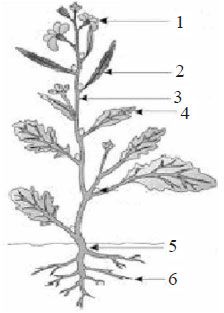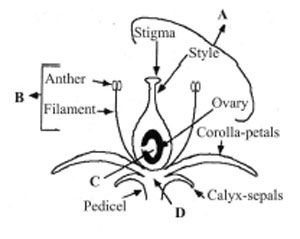Identify the different types of aestivation (A, B, C and D) in corolla and select the correct option.

A-Valvate, B-Twisted, C-Imbricate, D-Vexillary
A-Vexillary, B-Valvate, C-Twisted, D-Imbricate
A-Imbricate, B-Vexillary, C-Valvate, D-Twisted
A-Twisted, B-Imbricate, C-Vexillary, D-Valvate
Correct Answer :
A. A-Valvate, B-Twisted, C-Imbricate, D-Vexillary
Aestivation is the arrangement of petals and sepals with respect to one another in a floral bud before it opens. The given figure shows different types of aestivation. Figures A, B, C and D show valvate, twisted, imbricate and vexillary aestivation. In valvate aestivation, sepals or petals or tepals just touch one another without any overlapping, e.g. Calotropis. In twisted aestivation, one margin of each petal overlaps the margin of an adjacent petal and the other margin being overlapped by margin of another adjacent petal, e.g. China rose, cotton. If the margin of sepals or petals overlap one another but not in any particular direction as in Cassia and Gulmohar, the aestivation is called imbricate. Vexillary is the characteristics aestivation of corolla of pea when posterior petal is outermost.
Related Questions
The primary roots and its branches constitute the
fibrous root system.
tap root system.
adventitious root system.
all of the above
The main purpose of phyllotaxy for the leaves is to provide sufficient_______.
soil
air
water
light
Seeds are regarded as products of sexual reproduction because they
can be stored for long time.
are result of fusion of pollen tube.
are result of fusion of gametes.
give rise to new plants.
Identify the inflorescence shown by the given figures A and B.

A-Cymose, B-Racemose
A-Racemose, B-Cymose
A-Racemose, B-Racemose
A-Cymose, B-Cymose
Which one of the following structure is not associated with gynoecium?
Ovary
Style
Stigma
Filament
X is the outermost whorl of the flower and contains Y. Y is green, leaf like and protect the other whorls of the flower. Identify X and Y.
X - Calyx; Y - Sepals
X - Corolla; Y - Petals
X - Gynoecium; Y - Fruit
X - Androecium; Y - Ovary
Which of the following is correct with reference to floral character of family solanaceae?
Racemose, zygomorphic, unisexual, floral characters
Racemose, zygomorphic, bisexual, polypetalous
Axillary, bisexual, actinomorphic, epipetalous
Axillary, actinomorphic, bisexual, epipetalous
The region of the root-tip whose cells undergo rapid elongation and enlargement and are responsible for the growth of the root in length is called the
region of maturation.
region of elongation.
region of meristematic activity.
root-hairs.
Floral features are chiefly used in angiosperms identification because
flowers are of various colours.
flowers can be safely pressed.
reproductive parts are more stable and conservative than vegetative parts.
flowers are good materials for identification.
Rearrange the following zones seen in the regions of root tip and choose the correct option.
(A) Root hair zone
(B) Zone of meristems
(C) Root cap zone
(D) Zone of maturation
(E) Zone of elongation
C, B, E, A, D
A, B, C, D, E
D, E, A, C, B
E, D, C, B, A
Most prominent function of inflorescence is
dispersal of seeds.
formation of more fruits.
formation of pollen grains.
dispersal of pollens.
In flower (X), the gynoecium occupies the highest position while the other parts are situated below it. The ovary in such flowers is said to be Y. Identify X and Y and select the correct option.
X - Epigynous, Y - Inferior
X - Perigynous, Y - Superior
X - Hypogynous, Y - Superior
X - Perigynous, Y - Half-inferior
The given figure shows a typical structure of monocotyledonous seeds. Identify A, B, C, D and E parts marked in the given figures.

A - Endosperm, B - Embryo, C - Scutellum, D - Coleorhiza, E - Coleoptile
A- Embryo, B - Endosperm, C - Scutellum, D - Coleoptile, E - Coleorhiza
A - Endosperm, B - Embryo, C - Scutellum, D - Coleoptile, E - Coleorhiza
A - Embryo, B - Endosperm, C - Scutellum, D - Coleorhiza, E - Coleoptile
Which one of the following characteristics is not related to gynoecium?
It is the female reproductive part of the flower.
It is composed of stamens.
Stigma is usually at the tip of the style and is the receptive surface for pollen grains.
Each ovary bears one or more ovules attached to a flattened, cushion like placenta.
Matching colmun I with column II and choose the correct option.
| Column I | Column II |
|---|---|
| A. Coleorhiza | I. Grapes |
| B. Food storing tissue | II. Mango |
| C. Parthenocarpic fruit | III. Maize |
| D. Single seeded fruit | IV. Radicle developing from monocarpellary superior ovary |
| E. Membranous | V. Endosperm seed coat |
A III, B I, C IV, D II, E V
A IV, B II, C V, D I, E III
A V, B I, C III, D IV, E II
A IV, B V, C I, D II, E III
Which of the following statement (s) is/are not correct?
- Calyx and corolla are reproductive organs of a flower.
- Zygomorphic flower can be divided into two equal radial halves in any radial plane.
- Flowers without bracts are termed as bracteate.
- Parthenocarpic fruit is formed after fertilization of the ovary.
- In legumes, seed is non-endospermic.
- Radical buds develop on roots.
(i) , (ii), (iii) and (iv)
(i), (ii) and (v)
(iii), (iv) and (vi)
(iv), (v) and (i)
Identify the kind of phyllotaxy shown in the given figures A, B, and C.

A-Alternate, B - Opposite, C - Whorled
A- Whorled, B - Opposite, C -Alternate
A-Alternate, B - Whorled, C - Opposite
A-Whorled, B -Alternate, C - Opposite
The given figure shows the parts of flowering plant. Which parts of the given figure were involved in the following functions:
- Storing reserve food material
- Synthesis of plant growth regulators.
- Absorption of water and minerals from the soil.
- Providing a proper anchorage to the plant parts

5 and 6
1, 2 and 6
1, 2, 3 and 4
2, 4, 5 and 6
The given figures (A & B) show two types of compound leaves. Choose the option which identity the correct compound leaf and their example (c).

A - Pinnately compound leaf, C - Neem
A - Palmately compound leaf, C - Neem
B- Pinnately compound leaf, C - Silk cotton
B- Palmately compound leaf, C - Silk cotton
Match column - I, II and III and choose the correct option.

A - V, t; B - II, s; C -I, r; D -III, q; E -IV, p
A - I, t; B - II, s; C - III, r; D - IV, p; E - V, q
A - V, p; B - II, s; C - I, q; D - III, r; E - IV, t
A - V, p; B - III, q; C - II, s; D - I, t; E - IV, r
Which of the following part elongates directly and leads to the formation of primary roots?
bud
radicle
plumule
root hair
Which one of the following option shows the correct labelling of the structure marked as A, B, C & D?

A - Gynoecium, B - Megasporophyll, C - Ovule, D - Thalamus
A - Gynoecium, B - Stamen, C - Seed, D - Thalamus
A - Microsporophyll, B - Stamen, C - Ovule, D - Thalamus
A - Gynoecium, B - Stamen, C - Ovule, D - Thalamus
Cotyledons and testa respectively are edible parts in which of the following group?
walnut and tamarind
cashew nut and litchi
french bean and coconut
groundnut and pomegranate
When a flower can be divided into two equal radial halves in any radial plane passing through the centre, it is known as
actinomorphic
zygomorphic
asymmetric
bisymmetric
Which of the following statements is correct?
Imbricate aestivation is found in papilionaceous family.
Generally sepals are green, leaf like and protect the flowers in the bud stage.
In cymose type of inflorescence, the main axis terminates in a flower, hence is limitless in growth.
In axile placentation ovary is one chambered but it becomes two cambered due to formation of the false septum.
Match the column I with column II and choose the option which shows their correct match.
| Column I | Column II |
|---|---|
| A. Placentation | (i) Arrangement of flowers on the rachis |
| B. Aestivation | (ii) Modified shoot for sexual reproduction |
| C. Inflorescence | (iii) Arrangement of various whorls in the bud |
| D. Flower | (iv) Arrangement of ovules within an ovary |
A - (i), B - (ii), C - (iii), D - (iv)
A - (iii), B - (i), C - (ii), D - (iv)
A - (iii), B - (i), C - (iv), D - (ii)
A - (iv), B - (iii), C - (i), D - (ii)
Which of the following represents the floral characters of liliaceae?
Six tepals, zygomorphic, six stamens, bilocular ovary, axile placentation.
Actinomorphic, polyphyllous, unilocular ovary, axile placentation.
Tricorpellary, actinomorphic, polyandrous, superior ovary, axile placentation.
Bisexual, zygomorphic, gamophyllous, inferior ovary, marginal placentation.
Which is not a stem modification ?
Rhizome of ginger
Corm of Colocasia
Pitcher of Nepenthes
Tuber of potato
Statement 1 : A simple leaf has undivided lamina.
Statement 2 : Leaves showing pinnate and palmate venations have various type of incisions.
Statement-1 and statement-2 are true and statement-2 is a correct explanation for statement -1.
Statement -1 and statement -2 are true but statement-2 is not a correct explanation for statement-1.
Statement-1 is true and statement-2 is false.
Both the statements are false.
Which of the following statement(s) is /are correct?
- Many plants belong to family fabaceae are good ornamentals (Tulip, Gloriosa), source of medicine (Aloe) and vegetables (Asparagus).
- The plumule and radicle are enclosed in sheaths which are called coleorhiza and coleoptile respectively.
- A flower having either only stamens or only carpels is unisexual.
- Basal, alternate, linear, exstipulate with parallel venation types of leaves is found in the family liliaceae.
Only (i)
Both (i) and (ii)
Both (iii) and (iv)
All of these
